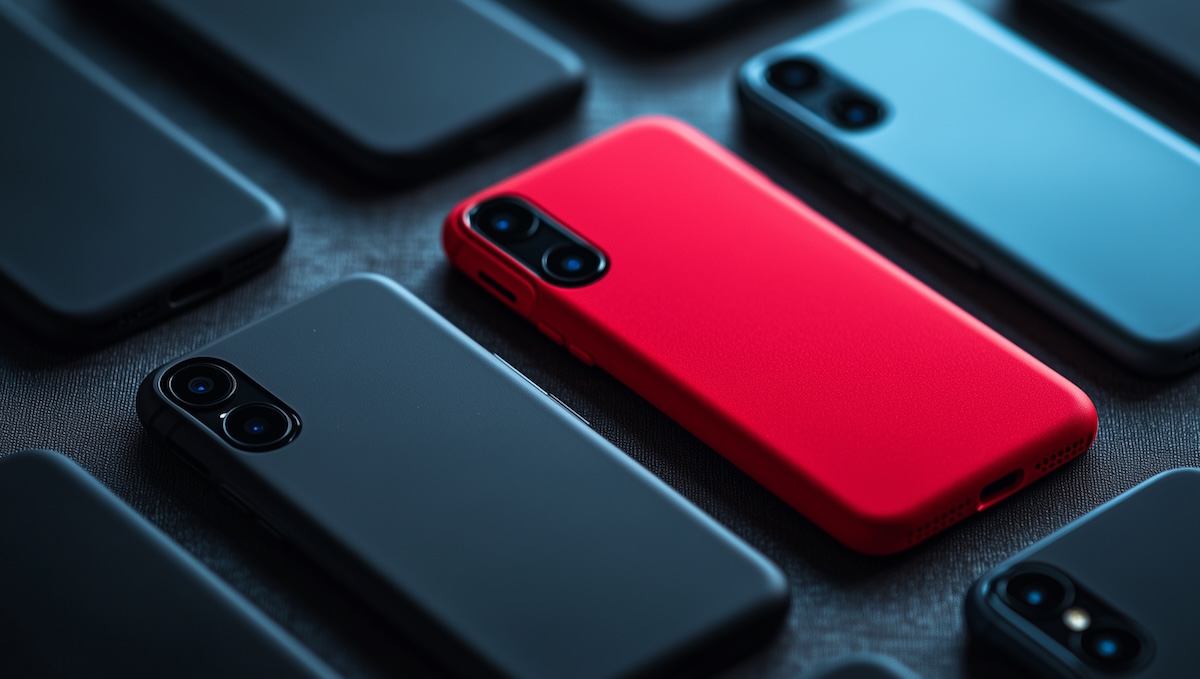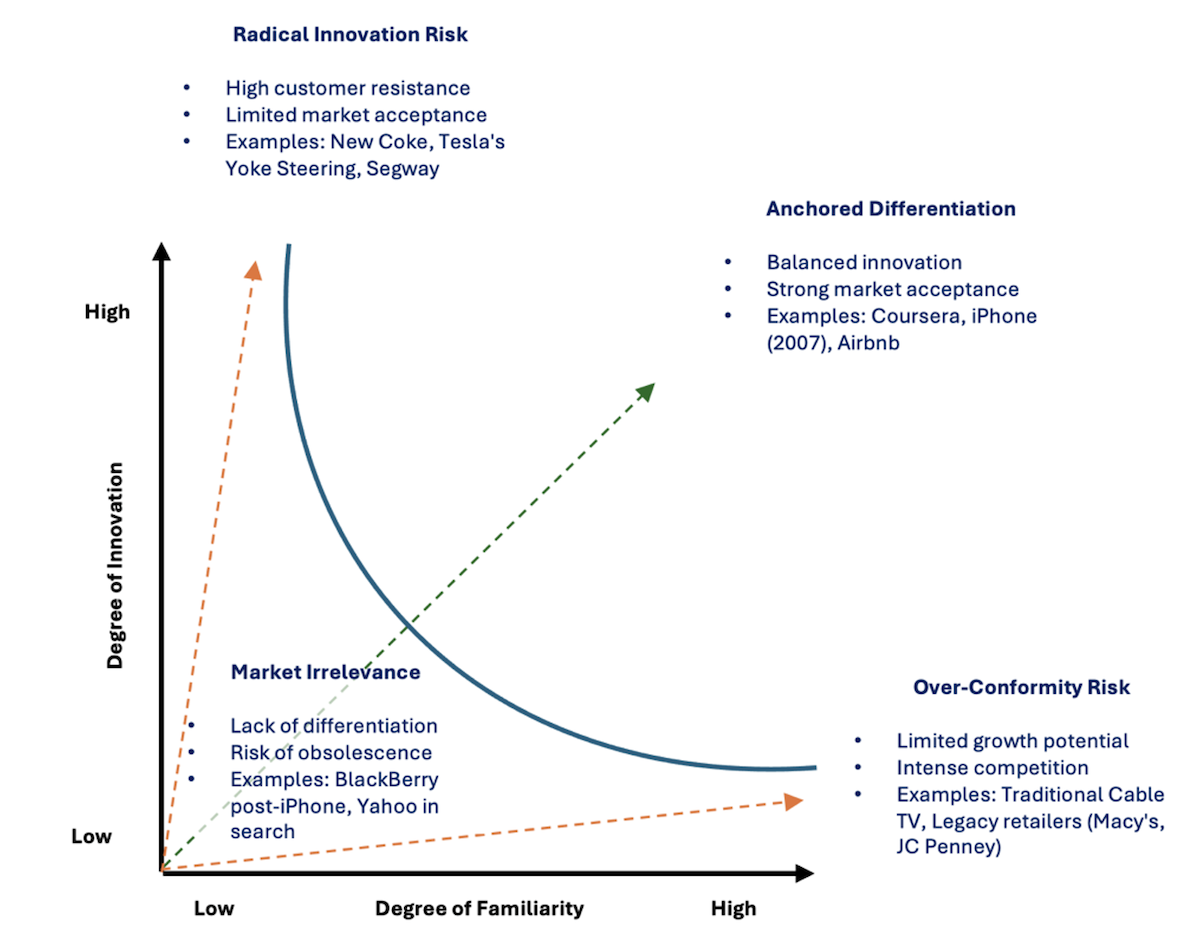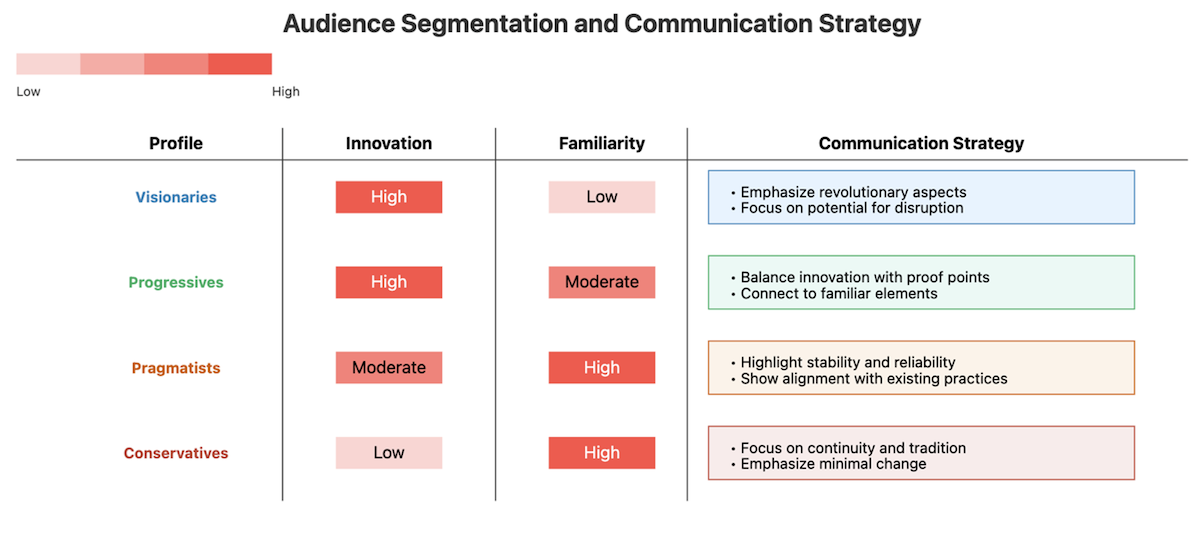California Management Review
California Management Review is a premier professional management journal for practitioners published at UC Berkeley Haas School of Business.
by Majid Majzoubi, Eric Yanfei Zhao, and Rudolphe Durand

Image Credit | ivlianna
Innovation and differentiation drive competitive advantage. In a market where consumers constantly seek the next big thing, companies race to outpace rivals by offering novel products and services. After all, who wants the dull and familiar when the exciting and new are within reach? Being different is often hailed as a hallmark of visionary leadership and forward-thinking strategy.
C. A. O’Reilly III & M. L. Tushman, “Organizational Ambidexterity in Action: How Managers Explore and Exploit,” California Management Review, 53/4 (2011): 5-22.
S. Magistretti, C. Dell’Era, C. Cautela, & J. Kotlar, “Design Thinking for Organizational Innovation at PepsiCo,” California Management Review, 65/3 (2023): 5-26.
But sometimes, differentiation goes too far, pushing away the very customers a company aims to attract. Consider Tesla’s introduction of the yoke steering wheel in its Model S and Model X vehicles. Departing from the traditional circular steering wheel, the yoke was meant to symbolize cutting-edge innovation. Instead, it faced widespread criticism. Drivers found it uncomfortable and unwieldy, especially during low-speed maneuvers. What was intended as a futuristic feature ended up feeling foreign and impractical to many customers.
A similar misstep occurred with Coca-Cola’s launch of “New Coke” in 1985. Aiming to rejuvenate its brand and counter Pepsi’s growing market share, Coca-Cola reformulated its classic soda. The new taste was indeed different—but that was the problem. Loyal customers rejected the change vehemently, leading to public outcry and demands for the original formula. The fiasco taught a hard lesson: consumers don’t always want new; familiarity holds significant value.
These examples highlight a critical insight: while innovation and uniqueness are essential, excessive or misaligned differentiation can backfire.
So, What’s the Solution? A Middle Ground?
Aware of the risks of over-differentiation, some companies try a straightforward fix: strike a balance between being unique and conforming to industry norms. They aim to innovate, but not so radically that they alienate their audience; to stand out, but not so much that they become unrecognizable.
But is this balancing act truly sufficient? Settling for the middle ground can sometimes result in a lackluster position—neither here nor there. By trying to be both different and the same, companies risk becoming unremarkable, offering little to excite customers or distinguish themselves from competitors. Mediocrity can be the unintended consequence of aiming for the average.
To achieve optimal distinctiveness, organizations need more than just a compromise. They should embrace more sophisticated strategies that address marketplace complexities.
Specifically, companies should consider:
By delving into these advanced strategies, businesses can innovate effectively without the backlash that often comes with excessive differentiation. They can stand out meaningfully where it matters most while fitting in where it counts, achieving sustainable competitive advantage in a complex and dynamic marketplace.
Innovation doesn’t have to be all or nothing. Companies can push boundaries in certain areas while maintaining familiarity in others, offering groundbreaking products or services without alienating customers or audiences. This approach, known as anchored differentiation, involves differentiating radically in one domain while providing anchors of familiarity to ease adoption.
Customers and audiences assess new offerings based on a mix of novelty and familiarity. Too much novelty can be overwhelming or seem risky; too much familiarity may make a product blend in with existing options. The Segway’s fate illustrates the risks of insufficient anchoring – despite its revolutionary personal transportation technology, it struggled to find mainstream acceptance because it lacked familiar reference points in consumers’ existing idea of what a transportation machine would look like.
Other firms face the opposite challenge of over-conformity, where they maintain strong connections to familiar elements but fail to innovate meaningfully. The main challenge here is that with no meaningful differentiation, companies could easily get lost in the crowd and lose profitability due to increased competition around similar products and business models. Firms falling in this category have limited growth potential as they do not have a differentiation point that could give them inimitable and sustainable competitive advantage; they easily get imitated by one another. Furthermore, consumers might get bored with their offerings and move away from them. Sometimes consumers demand fresh, innovative models and products to meet their evolving needs and preferences. Traditional cable TV providers like Comcast Xfinity illustrate this risk. While maintaining reliable service and familiar channel packages, a lack of innovation that would allow them to stay current with the changing competitive environment left them vulnerable to streaming services that better met evolving consumer preferences. Legacy retailers like Macy’s and J.C. Penney faced similar challenges—despite their strong brand heritage and familiar retail formats, they’ve struggled to remain relevant by clinging to traditional retail models while failing to adapt to modern shopping preferences and digital commerce.
Some companies fall into the trap of market irrelevance, where they don’t push the boundaries of innovation while at the same time becoming unfamiliar to their audience. These companies are often stuck in an old paradigm that is neither innovative nor familiar for consumers anymore, risking obsolescence and irrelevance. BlackBerry phone’s fate exemplifies this trajectory—once a market leader, it continued focusing on physical keyboards while the market moved towards touchscreens without keyboards. Today’s typical consumer finds the keyboard not only dated, but also somewhat foreign and unfamiliar. One might argue that Yahoo’s search service experienced a similar fate. Once a familiar and innovative company, its search feature soon lost its edge as a pioneering and leading search provider, and consumers today would find it also quite unfamiliar compared to the search services they have grown accustomed to.
Organizations navigating these two dimensions—degree of innovation and degree of familiarity—often fall into one of three traps: radical innovation, over‐conformity, or market irrelevance. Figure 1 illustrates how the sweet spot lies in achieving what Chan et al. (2021) term anchored differentiation. By combining groundbreaking innovations that capture attention and disrupt the status quo with strong anchors of familiarity that tap into consumers’ inherent comfort with the known and the familiar, firms can introduce substantive change without alienating their audiences. This balanced approach enables companies to remain forward‐thinking, spark excitement, and mitigate the risks of overwhelming or confusing their customers—by incorporating enough anchors of familiarity to build trust and ease adoption.

Figure 1 – The Simultaneous Need for Innovation and Familiarity
Firms can strategically select anchors of familiarity to make their innovations more approachable and acceptable to the target audience. These anchors can take various forms, such as adopting recognizable names or labels, forming partnerships with reputable organizations, retaining certain elements of traditional business models, or incorporating design features from successful past products.
Coursera, for instance, offered a novel platform for online education—a significant departure from traditional classroom learning. To anchor this innovation, Coursera partnered with prestigious universities like Stanford and Yale. These partnerships lent credibility and familiarity, making users more comfortable embracing the new learning format.
Another strategy companies employ is associating themselves with well-known brands or products to enhance their own familiarity in the market. Startups frequently describe themselves as the “Uber of” their industry—whether it’s healthcare, logistics, or food delivery. This analogy instantly anchors their business model and value proposition by referencing Uber’s widely recognized on-demand service model. By doing so, they provide potential customers and investors with an immediate understanding of their offering, anchored in the familiarity of Uber’s success.
Apple’s product naming strategy is a prime example of anchoring innovation in familiarity. When Steve Jobs unveiled the iPhone in 2007, he declared, “Today, Apple reinvents the phone.” Despite introducing a device that was a substantial leap forward in technology and user experience—combining a phone, an iPod, and an internet communicator—Apple chose to retain the term “phone” in its product name. This deliberate choice anchored the groundbreaking features of the iPhone to a familiar concept. The familiarity of the term “phone” provided a comfortable reference point amidst a groundbreaking innovation. The same strategy was employed with the launch of the Apple Watch. Although it entered a new product category that blended features of smartwatches, fitness trackers, and health monitors, Apple opted to call it simply “Watch.” By using a familiar term, Apple anchored the innovative functionalities of the device to a well-understood and everyday accessory.
To achieve optimal distinctiveness, it’s crucial to recognize that organizations often face a portfolio of audiences with different expectations and tolerances for innovation versus conformity. A one-size-fits-all approach frequently falls short because what appeals to one audience may deter another. Therefore, the first step is to identify which audience profile you are engaging with—based on how they weigh the novelty of an innovation against the comfort of familiarity—so you can determine the most effective anchored innovation strategy.
Drawing on research into how audiences interpret and respond to unconventional signals of innovation (Gouvard & Durand, 2023; Zhao, 2022), we identified four distinct audience profiles—Visionaries, Progressives, Pragmatists, and Conservatives—based on varying levels of tolerance for innovation and need for familiarity. Each profile values novelty and familiarity differently, underscoring the need for tailored communication strategies to achieve “optimal distinctiveness” and resonate more effectively with diverse stakeholders.

Figure 2 - Tailoring Communication Strategies by Audience Profiles to Achieve Optimal Distinctiveness
This chart segments audiences based on their tolerance for novelty and need for familiar anchors, illustrating how firms can customize messaging to each profile.
Visionaries are audiences who actively seek novelty and disruption. They have a high tolerance for risk and value being the first to experience unique offerings. For them, familiarity may signal staleness, making radical innovation particularly appealing. When communicating with Visionaries, firms should emphasize the revolutionary aspects of their products or services, highlighting potential market disruption and focusing on future possibilities. Showcasing cutting-edge technology and minimizing references to traditional approaches can resonate strongly with this group.
Progressives represent audiences who value innovation but also appreciate some anchoring to the familiar. They are excited by innovation, but are deliberate before buying in. Companies should communicate with Progressives by balancing innovation messaging with tangible proof points. Showing connections to existing successful practices, while predominantly highlighting the innovative aspects of the product, helps align the new with the known for this specific audience type.
Pragmatists prefer familiarity but are open to innovation. They are risk-aware and seek proven solutions, valuing stability with incremental improvements. This group looks for strong validation before embracing new ideas. When communicating with Pragmatists, firms should lead with messages of stability and anchors of familiarity. Firms can then present innovation as a natural evolution, emphasizing its necessity and presenting all the steps taken to mitigate the costs of switching to the new technology and minimizing the risks associated with it.
Conservatives are audiences with a strong preference for the familiar, and are highly risk-averse. They tend to resist change unless it is absolutely necessary and place significant value on a proven track record. Communication with Conservatives should focus primarily on anchors of familiarity, minimizing emphasis on new and differentiating factors and presenting any innovation as minor enhancements. Emphasizing continuity, tradition, safety, and long-term stability helps maintain their trust and confidence.
Successfully navigating these varying audience profiles means tailoring how you frame the same core product or service. While the innovation remains constant, the emphasis shifts to align with each audience’s unique values and needs. Tailoring doesn’t require changing your strategy for every audience, but rather highlighting the features and benefits that are most meaningful to each profile.
In the fashion industry, luxury brands skillfully balance innovation and familiarity in their presentation to both avant-garde fashion enthusiasts and mainstream consumers. High-end designers unveil bold, unconventional designs during fashion weeks, capturing the attention of trendsetters and the media. These runway shows position the brand at the forefront of fashion innovation, appealing to style influencers and early adopters seeking exclusivity. Recognizing that such avant-garde designs might seem too foreign to the typical consumer, these brands also produce ready-to-wear collections that adapt runway concepts into more accessible, wearable styles. By retaining signature elements while providing the comfort of familiarity, fashion brands satisfy the desire for innovation among fashion-forward customers while ensuring broader market appeal through familiarity.
Amazon Web Services (AWS) is also a good example of a company tailoring its differentiation messaging to diverse audiences. For developers and startups eager for the latest technologies, AWS emphasizes cutting-edge services like artificial intelligence and machine learning, highlighting the potential for innovation and rapid scalability. Messaging focuses on empowering users to disrupt industries and build transformative applications. For enterprise clients and IT departments, AWS underscores reliability, security, and compliance. They emphasize features like robust data protection, adherence to industry regulations, and compatibility with existing systems. This reassures larger organizations that AWS is a trustworthy partner capable of handling critical workloads without compromising on established standards.
It is important to note that such a strategy is not without challenges. Companies might face issues when implementing audience-specific communication strategies. One challenge is message inconsistency, which can occur when communications contradict each other across segments. The key is to ensure that all communications align with the core values and offerings of the company, even as different aspects are highlighted to appeal to various audiences. Another common challenge is over-segmentation, where companies create too many variations in their messaging and dilute their core message. Overcomplicating the communication strategy can lead to confusion both internally and externally. The key here is focusing on the most important audiences—the ones who have the most significant impact on business outcomes.
Achieving sustainable competitive advantage in today’s complex marketplace requires more than simply striking a balance between novelty and familiarity. Companies can position themselves for success by innovating boldly while anchoring strategically, and by tailoring their differentiation to multiple audience profiles with distinct preferences. By pushing boundaries where it matters and preserving familiarity where it counts—and by framing those innovations in ways that resonate with Visionaries, Progressives, Pragmatists, and Conservatives—organizations can introduce compelling new offerings while mitigating the risks of alienation or irrelevance.
Chan, Tian Heong, Yonghoon G. Lee, and HeeJung Jung. “Anchored differentiation: The role of temporal distance in the comparison and evaluation of new product designs.” Organization Science 32.6 (2021): 1523-1541.
Deephouse, David L. “To be different, or to be the same? It’s a question (and theory) of strategic balance.” Strategic management journal 20.2 (1999): 147-166.
Durand, R., & Haans, R. F. (2022). Optimally distinct? Understanding the motivation and ability of organizations to pursue optimal distinctiveness (or not). Organization Theory, 3(1), 26317877221079341.
Gouvard, P., & Durand, R. (2023). To be or not to be (typical): Evaluation-mode heterogeneity and its consequences for organizations. Academy of Management Review, 48(4), 659-680.
Majzoubi, M., & Zhao, E. Y. (2023). Going beyond optimal distinctiveness: Strategic positioning for gaining an audience composition premium. Strategic Management Journal, 44(3), 737-777.
Taeuscher, K., & Rothe, H. (2021). Optimal distinctiveness in platform markets: Leveraging complementors as legitimacy buffers. Strategic Management Journal, 42(2), 435-461.
Zhao, Eric Yanfei, et al. “Optimal distinctiveness: Broadening the interface between institutional theory and strategic management.” Strategic Management Journal 38.1 (2017): 93-113.
Zhao, E. Y., Ishihara, M., Jennings, P. D., & Lounsbury, M. (2018). Optimal distinctiveness in the console video game industry: An exemplar-based model of proto-category evolution. Organization Science, 29(4), 588-611.
Zhao, E. Y. (2022). Optimal distinctiveness: A new agenda for the study of competitive positioning of organizations and markets. Cambridge University Press.